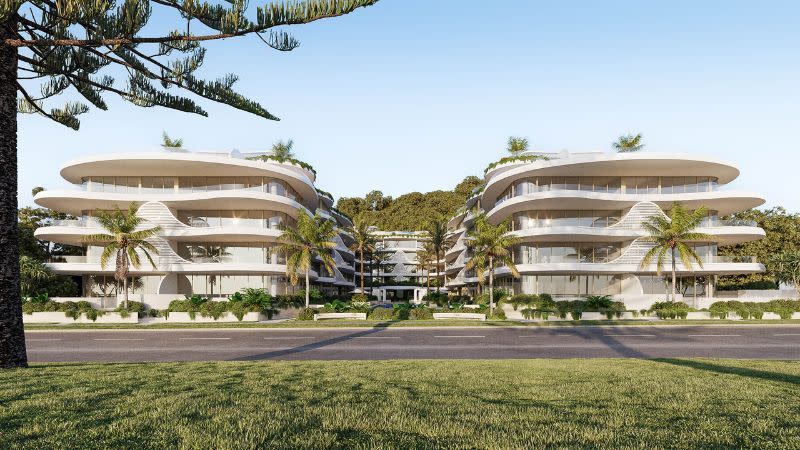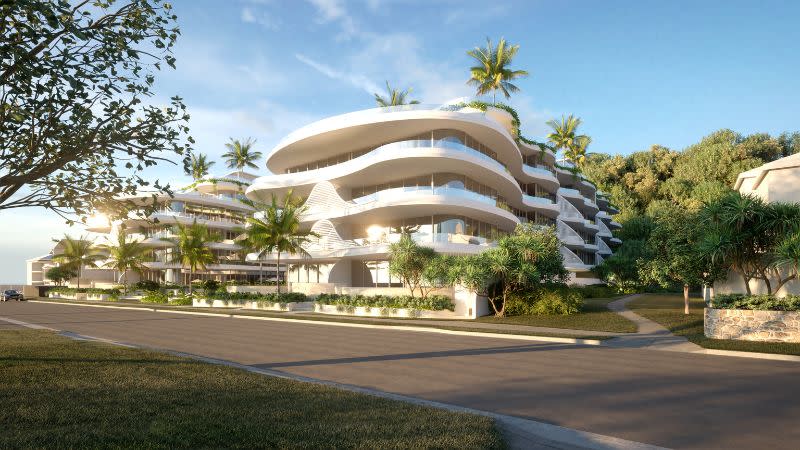Approval Heralds $500m New Era for Miami Beachfront

High-end it certainly will be.
Just do the maths: a $500-million end value, 45 luxury lowrise apartments—some of them up to six times the average size of a new-built home.
On the beachfront strip in the shadow of the Gold Coast’s Magic Mountain, the green light has been given to Monaco Property Group’s hedonistic vision.
Led by developers Jonathan Grasso and Jay McPhee, its approved five-storey U-shaped scheme was designed by BDA Architecture in collaboration with Koichi Takada Architects.
Two, three and five-bedroom apartments—ranging from 237sq m to more than 1400sq m—will encompass a centrepiece 2200sq m communal lifestyle precinct with ocean views, including a bathhouse, fitness centre, resort-style pool and its own concierge service.
Crowning the development, its penthouses will also incorporate private roof terraces, each with outdoor dining and lounge facilities, swimming pools, spas, adjoining sun terraces and landscaped seating areas.
Grasso said construction was slated to begin in early 2026, with completion expected in the third quarter of 2028.
“Our vision is to create a legacy project for the Gold Coast, one that not only honours the history of the site but also elevates its future, setting a new standard for coastal living in Australia,” he said.

Touted as heralding a new era along the Miami beachfront, it will replace a two-storey 1960s-built holiday resort, formerly known as Nobby’s Outlook, on the 7284sq m holding at 122-130 Marine Parade.
The site is bordered by an 80m frontage to Marine Parade to the east and Nobby Hill—also known as Magic Mountain for a long-gone amusement park that once adorned it—to the west.
Monaco Property Group put its foot on the site this year and last week settled the site’s $70-million acquisition—one of the city’s biggest deals for a beachfront property for some time.
It was bought from Melbourne-based Moose Toys boss Paul Solomon, who in 2017 paid $23.75 million for the property, which he subsequently refurbished and renamed Nalu.
The approved redevelopment of the site by Monaco Property Group will give a nod to its lowrise predecessor by adopting its name—a word meaning “wave” in Hawaiian.
Grasso said the go-ahead from the Gold Coast City Council “marks an exciting milestone” for the future of the site, which has been circled by a throng of other developers over the years.

In 2010, the former ASX-listed Sunland Group put a $40-million offer on the table for the site but the deal was thwarted by a sole unit owner who refused to sell.
Monaco Property Group lodged its development application in April with a design statement describing its built form as having “sweeping curved edges wrapping in a U-shape inside the northern, western and southern side boundaries”.
“This project embraces the Miami context of lush landscape, open architecture, beachfront living and active lifestyle,” it said. “The building has been positioned so as to open out to the ocean and yet blend with the mountain behind.”
A planning report noted although Marine Parade largely had a three-storey height limit, there were several existing buildings that ranged from four to nine storeys.
“The character of Marine Parade is mixed and best described as representing a transitional phase as older traditional dwellings and unit buildings are making way for more contemporary built form incorporating a mix of substantial detached dwellings and multiple dwelling buildings of varying heights and scale,” it said.















